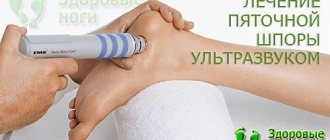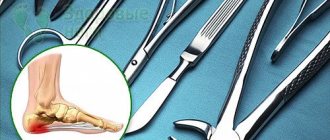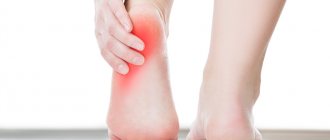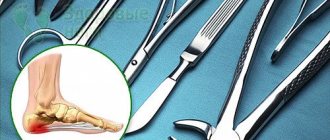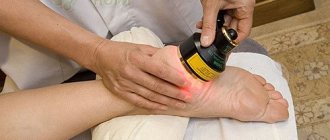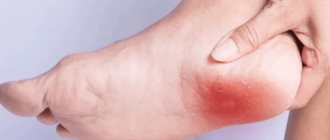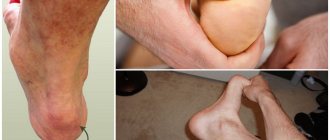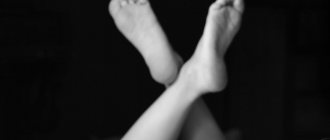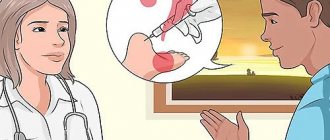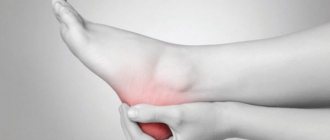A heel spur (also called plantar fasciitis) is the result of permanent damage to the plantar ligament that connects the heel bone to the forefoot. Due to regular traumatic effects, an osteophyte is formed in the heel bone, which is a heel spur. At the initial stage, conservative therapy can help in treatment. If the pathology is advanced, the only effective treatment option is surgical treatment.
Causes
According to statistics, in 90% of cases the cause of the development of this pathology is flat feet. It is because of this disorder that the proliferation of osteophytes occurs.
In addition, other factors may influence the development of the pathological process. Let's consider the main ones:
- Heel bone injury.
- Having excess weight.
- Old age (over 50 years old).
- The presence of diseases of the musculoskeletal system.
- Disruption of metabolic processes in the body, in which salt deposition occurs.
- Poor posture, which causes gait to suffer.
- Wearing low-quality or uncomfortable shoes, perhaps the wrong size.
- Regular increased physical activity.
Hereditary predisposition should also be noted. If you have close relatives suffering from heel spurs, there is a high probability that this pathology will affect you too.
Presence of spurs in children
Heel tumors can also occur in young patients. Moreover, the cause is standard factors - flat feet, excessive body weight, injury, diseases of the musculoskeletal system, infectious lesions. The problem is complicated by the anatomy of the child's foot. Until the age of 18, it is excessively elastic and subject to rapid deformation.
The treatment method is selected taking into account the age characteristics of the patient and the severity of the disease. Usually doctors limit themselves to conservative therapy. The effectiveness of treatment depends on correct identification of the disease. The main signs of the disease are pain in the heel, disturbances in gait or posture, and problems with decreased motor activity. Parents need to constantly monitor the condition of their child’s feet. It is important to exclude calluses, ingrown toenail syndrome, and bruises, which can lead to deformities and injuries.
Shoes for a child should be selected individually according to age. Booties are suitable only for the smallest children who do not yet walk, but at the beginning of physical activity, preference should be given to shoes with leather soles and 1 cm heels. Shoes should be clearly fixed on the leg. It is important to completely avoid wearing flip-flops and flip-flops. Ballet flats and sneakers are not suitable for frequent wearing. You should be careful when using used shoes. After all, each child tramples the insole and wears out the sole in his own way.
Alarming symptoms
The first sign of the development of pathology is pain in the heel area. As a rule, the pain appears in the morning. At the same time, during the day, no discomfort may often be observed. Over time, the pain intensifies and can be severe. Patients describe them to the doctor as a feeling of “a nail in the heel.” The pain worsens after being at rest for a long time. After physical activity, the discomfort may subside a little, but during the evening rest the pain returns.
Additional signs include the following:
- Swelling and redness of the heel area.
- The appearance of rough calluses in the heel area.
- When palpating the affected area, sharp unpleasant sensations may be observed.
Very often, patients with heel spurs experience changes in their gait. This is due to the fact that a person experiences pain when stepping on the heel. Therefore, the patient tries not to transfer his weight to the heel. Please note that the heel spur is not visually noticeable. Therefore, you should go to the doctor as soon as you feel discomfort in the heel area.
Diagnosis of emerging disorders
To effectively treat the disease and exclude the possibility of complications, a timely diagnosis is required. This cannot be done solely based on external examination and descriptions of the pain syndrome. The reason is that the sensation of pain in the heel area may be due to the development of other pathological abnormalities. These include:
- ankylosing spondylitis;
- gout;
- rheumatoid type arthritis;
- osteomyelitis;
- tuberculous lesions of bone tissue;
- injury, including tendon sprains, bruises;
- inflammatory changes in the foot area;
- infectious processes, including intestinal and urogenital.
The basic step in making a diagnosis is taking an anamnesis. However, correct diagnosis is impossible without a number of laboratory and instrumental studies. Doctors prescribe a general and biochemical blood test, a urine test, an X-ray examination and an MRI of the foot.
The goal of all diagnostic procedures is not only to make a correct diagnosis, but also to identify the cause of the disease and assess the severity of its course. If a patient has concomitant diseases, the doctor often prescribes consultative examinations with relevant specialists.
When is surgery necessary?
As a rule, the surgical method of treating heel spurs is used only in extreme cases: when the patient’s quality of life is seriously affected (severe pain, limited mobility is observed), and conservative therapy does not give a positive result.
You can find many traditional treatment methods on the Internet, but they are not able to alleviate the condition - at best, such self-medication will be useless, and at worst, the situation will worsen. Don't waste time on folk remedies! If the doctor recommends surgical treatment, then it is really necessary.
Before surgery, you should make sure that there are no contraindications to the procedure. This is for example:
- The presence of an acute infectious process in the body;
- Oncological diseases;
- Severe form of diabetes mellitus;
- Blood clotting disorder.
Treatment with medications
Conservative therapy involves influencing problem areas of the foot in order to eliminate inflammatory processes. The selection of necessary medications is carried out by orthopedic doctors, taking into account the individual characteristics of the patient. The most actively used are various gels and ointments. These products, like creams with infusions, will be effective in the initial stages of pathology development.
Injection painkillers and anti-inflammatory drugs are often prescribed. They are inserted directly into the heel joint area. This method of therapeutic action is more effective, but causes pain in the patient. Usually a set of injections is prescribed. The procedure should be performed exclusively by experienced doctors.
In the case of injection treatment, the dosage must be strictly observed. The drug must be injected to the desired depth with a high level of precision. If mistakes are made, it is possible to provoke inflammatory processes, the development of osteoporosis, and the formation of areas of suppuration. If the product is administered too often, damage and even destruction of fascial tissue is likely.
Painkiller patches, as well as antiseptics and natural substances, are easy to use. At the same time, analgesics themselves are not considered as drugs with medicinal effects. They are focused on pain relief. At the same time, the disadvantage of such drugs is the tendency of patients to become addicted and develop dependence.
When using any medications, possible contraindications should be taken into account, including individual intolerance to components or the development of serious diseases.
Physiotherapeutic effects
To reduce the severity of the exacerbation, the patient is prescribed a complex of gymnastics, massage manipulations, and ultrasound therapy. You can increase the effectiveness of medication by:
- electrophoresis, when medicinal substances are sent to deep zones of soft tissues through the use of low-voltage electrical pulses;
- sonophoresis - medications penetrate into soft tissues by exposing problem areas to ultrasonic waves.
Physiotherapeutic procedures often include injections of corticosteroids. These drugs belong to the group of steroid drugs with anti-inflammatory effects. With the simultaneous use of an anesthetic, they are injected into the sole or heel area.
The peculiarity of physiotherapy is that doctors can select the most effective manipulations, taking into account the individual characteristics of each patient.
Shock wave impact
Due to the impact of ultrasonic pulses on the body, calcium deposits are destroyed with the formation of tiny particles. They are eliminated by the bloodstream. In addition, with the help of shock wave therapy, regeneration processes in soft tissues are activated. There is a decrease in the severity of inflammatory changes and manifestations of swelling.
If the disease is at the initial stage of development, then shock wave therapy helps to completely get rid of disorders in the form of heel spurs. This technique is also used in cases where the use of other methods of influence is limited or prohibited. In advanced cases, inflammation is relieved and the proliferation of calcium deposits is inhibited or stopped.
At the same time, doctors note a number of contraindications:
- low blood pressure;
- period of bearing a child;
- heart rhythm problems;
- abnormalities in blood clotting processes;
- a state of intoxication caused, for example, by intestinal poisoning or taking medications;
- disturbances in the condition and functioning of the nervous system;
- the appearance of malignant neoplasms;
- development of thrombophlebitis in the affected area;
- the presence of an infectious lesion in the acute phase.
Ultrasonic exposure
Using an ultrasonic wave, you can eliminate pain and limit inflammatory changes. This effect is achieved by deep heating of the tissues. Ultrasound quickly penetrates the damaged fascia and activates healing at the cellular level. At the same time, other positive effects are achieved:
- relaxation of muscle tissue;
- activation of blood flow in the area of ligaments and tendons;
- reduction of swelling.
Using a laser
The therapeutic effect is produced by directing the light beam onto the damaged area. The result of the treatment can be seen after 2-6 sessions. The characteristics of the disease, the patient’s condition, and the characteristics of his body are taken into account. The laser penetrates to a considerable depth into the tissue area and begins to stimulate metabolic processes there, while activating regeneration processes.
Surgical intervention
The previously discussed therapeutic techniques are aimed at eliminating inflammatory changes, preventing or limiting the proliferation of bone tumors, and stimulating regeneration in soft tissues. Surgical treatment is associated with ensuring complete removal of the growth. However, there is no complete guarantee of recurrence of the tumor. This is the reason why surgery is prescribed only in extreme situations.
The peculiarities of the operation are determined by the nature of the disease. During the intervention, complete or partial eruption of the plantar fascia occurs. At the same time, the spur and all tissues that were damaged are removed. If the fasciotomy is complete (disconnecting), then the anatomy of the foot is disrupted. This causes gait disturbances, which leads to disability.
The minimum level of invasiveness of the effect is inherent in radiofrequency microtenomia. Burning is carried out by high frequency electromagnetic radiation. This leads to the destruction of damaged tissues and nerve fibers, as a result of which the pain syndrome is eliminated.
It is important to remember that the degree of effectiveness of any technique is determined by the timely diagnosis of the disorder and the constant prevention of the disease. Doctors warn against using traditional methods without consulting a specialist. In some cases, this approach can lead to lost time and complications.
Is preparation necessary?
As a rule, no special preparation for the operation is required. However, the patient needs to make sure that there are no contraindications, so he needs to undergo tests such as:
- General and detailed analysis of blood and urine;
- Blood clotting test;
- Blood test for HIV, hepatitis and syphilis;
- ECG, fluorography.
Additional types of instrumental diagnostics may also be prescribed, such as radiography, CT or MRI.
Immediately before the operation, you should follow the following doctor’s recommendations:
- You cannot eat for 7-8 hours before surgery;
- 3-5 days before the test you need to avoid alcoholic beverages;
- You should definitely tell your doctor about the medications you are constantly taking.
Removal methods
Today, surgical treatment of heel spurs can be carried out in various ways:
Classic removal.
Currently, this surgical technique is considered obsolete. With classic removal, the fascia is cut with a longitudinal incision, after which the doctor removes the bone-salt growth and salt deposits around it. The final stage is the installation of drainage to drain serous fluid, suturing and bandaging the damaged area.
Removal using an endoscope.
This technique is less traumatic. In this case, the removal of the growth is carried out through two small punctures using special tools and a miniature camera. After removing the heel spur, the doctor applies miniature sutures. Compared to the classical method of surgical intervention, recovery in this case is 2-3 times faster.
Minimally invasive technique under X-ray control.
This technique for removing calcaneal spurs is relatively new. To perform a surgical intervention, you only need to make one puncture through which the necessary instruments are inserted. The progress of the surgical procedure is monitored using x-rays. 12 hours after removal of the growths, the patient can already stand on his leg. The type of anesthesia is selected individually for patients. General anesthesia or local anesthesia may be used.
Which heel spur treatment method is suitable in your case is decided individually after consultation with your doctor.
Rehabilitation period
The duration of the rehabilitation period may vary. This depends on the chosen method of heel spur removal. For example, with classic removal, recovery can take about 2 weeks, with minimally invasive techniques - only 3-5 days.
To speed up the recovery process and avoid unpleasant consequences, it is recommended to carefully follow some medical recommendations:
- In the first days after surgery, it is recommended to provide maximum rest to the injured leg.
- The resumption of physical activity should be carried out gradually; in no case should the leg be subjected to sudden loads.
- Full physical activity, including sports, can be resumed no earlier than after a month and a half.
- Take all medications your doctor prescribes. To reduce the risk of complications, antibacterial and anti-inflammatory drugs may be prescribed. Painkillers can be used to reduce pain.
- It is usually recommended to wear orthotics or orthoses after surgery.
Timely treatment allows you to avoid negative consequences and complications. At the first signs of a pathological process, consult a doctor. More detailed information about heel spur removal can be obtained from your doctor at your appointment. Be healthy!
Algorithm for conducting a shock wave therapy session
To perform the shock wave therapy procedure, a special device is used that generates ultrasonic waves.
The procedure is performed with an innovative device that produces waves at ultrasonic frequencies. Before the session, the specialist treats the affected area with a gel with conductive properties, after which sensors are installed on the heel.
Next, an acoustic wave is applied, which is capable of penetrating to a depth of 4 cm. The sound quietly penetrates through the muscle layer and is reflected from the bone. As a result, the vibration structure changes and the damaged area is massaged.
During treatment, discomfort or pain may occur. The latter is an indication for stopping treatment and ordering additional studies to find the cause of the painful phenomena. For the purpose of recovery, courses of treatment are carried out intermittently.
